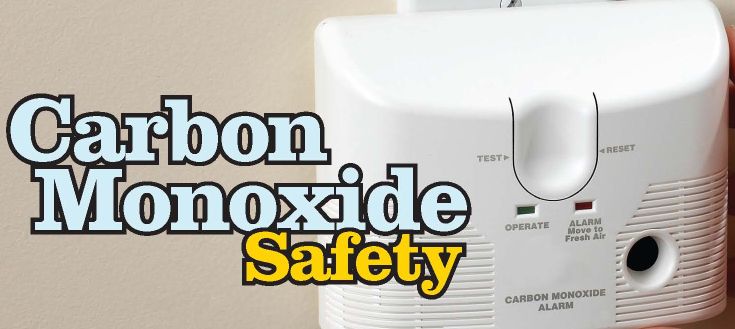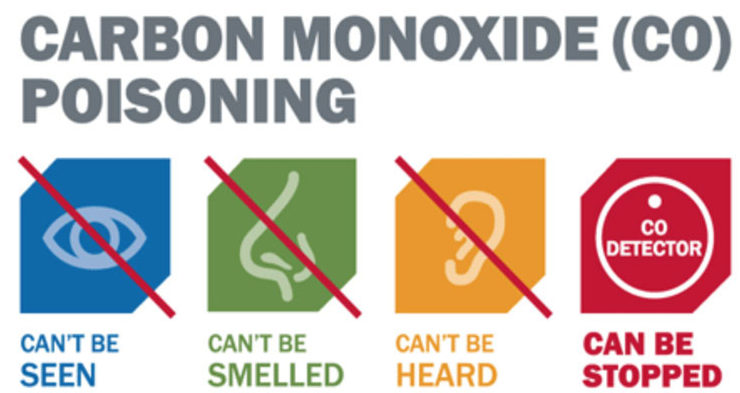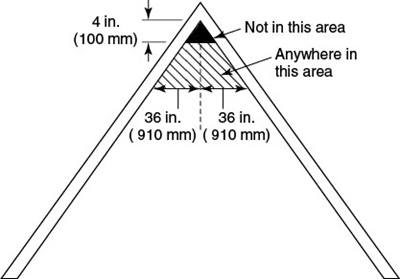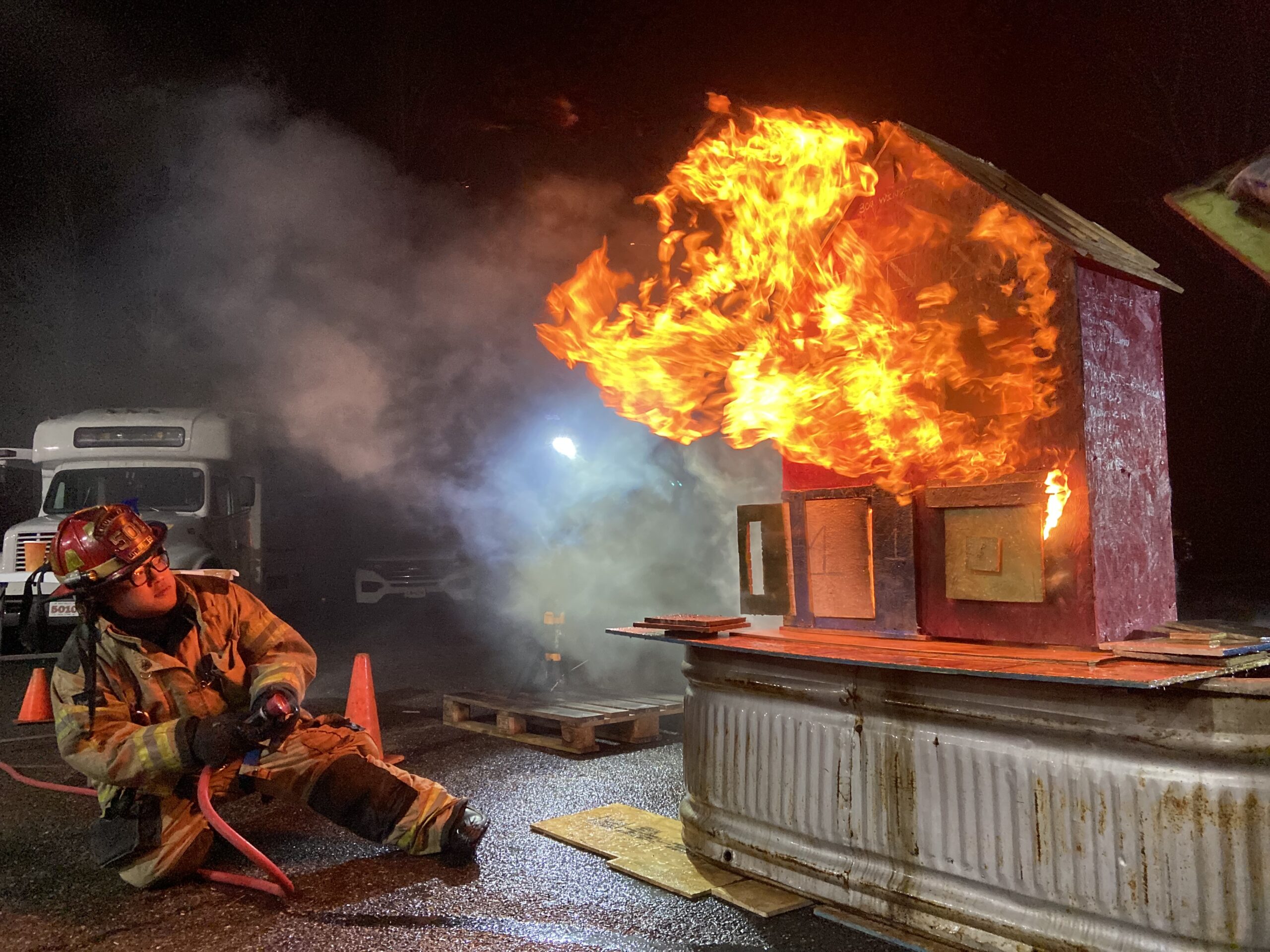CO Alarms
 Replace batteries in smoke alarms annually – better safe than sorry.Although the popularity of carbon monoxide (CO) alarms has been growing in recent years, it cannot be assumed that everyone is familiar with the hazards of carbon monoxide poisoning in the home.Often called the invisible killer, carbon monoxide is an odorless, colorless gas created when fuels (such as gasoline, wood, coal, natural gas, propane, oil, and methane) burn incompletely. In the home, heating and cooking equipment that burn fuel are potential sources of carbon monoxide. Vehicles or generators running in an attached garage can also produce dangerous levels of carbon monoxide.
Replace batteries in smoke alarms annually – better safe than sorry.Although the popularity of carbon monoxide (CO) alarms has been growing in recent years, it cannot be assumed that everyone is familiar with the hazards of carbon monoxide poisoning in the home.Often called the invisible killer, carbon monoxide is an odorless, colorless gas created when fuels (such as gasoline, wood, coal, natural gas, propane, oil, and methane) burn incompletely. In the home, heating and cooking equipment that burn fuel are potential sources of carbon monoxide. Vehicles or generators running in an attached garage can also produce dangerous levels of carbon monoxide.- The dangers of CO exposure depend on a number of variables, including the victim's health and activity level. Infants, pregnant women, and people with physical conditions that limit their body's ability to use oxygen (i.e. emphysema, asthma, heart disease) can be more severely affected by lower concentrations of CO than healthy adults would be.
- A person can be poisoned by a small amount of CO over a longer period of time or by a large amount of CO over a shorter amount of time.
- In 2010, U.S. fire departments responded to an estimated 80,100 non-fire CO incidents in which carbon monoxide was found or an average of nine such calls per hour. The number of incidents increased 96 % from 40,900 incidents reported in 2003. This increase is most likely due to the increased use of CO detectors, which alert people to the presence of CO.
CO Alarms Safety Tips — CO Alarms should be installed in a central location outside each sleeping area and on every level of the home and in other locations where required by applicable laws, codes or standards. For the best protection, interconnect all CO alarms throughout the home. When one sounds, they all sound.
-
Follow the manufacturer’s instructions for placement and mounting height.
-
Choose a CO alarm that has the label of a recognized testing laboratory.
-
Call your local fire department’s non-emergency number to find out what number to call if the CO alarm sounds.
-
Test CO alarms at least once a month; replace them according to the manufacturer’s instructions.
-
If the audible trouble signal sounds, check for low batteries. If the battery is low, replace it. If it still sounds, call the fire department.
-
If the CO alarm sounds, immediately move to a fresh air location outdoors or by an open window or door. Make sure everyone inside the home is accounted for. Call for help from the fresh air location and stay there until emergency personnel.
-
If you need to warm a vehicle, remove it from the garage immediately after starting it. Do not run a vehicle or other fueled engine or motor indoors, even if the garage doors are open. Make sure the exhaust pipe of a running vehicle is not covered with snow.
-
During and after a snowstorm, make sure vents for the dryer, furnace, stove, and fireplace are clear of snow build-up.
-
A generator should be used in a well-ventilated location outdoors away from windows, doors and vent openings.
-
Gas or charcoal grills can produce CO — only use outside.

Symptoms of CO poisoning
CO enters the body through breathing. CO poisoning can be confused with flu symptoms, food poisoning, and other illnesses. Some symptoms include shortness of breath, nausea, dizziness, lightheadedness or headaches. High levels of CO can be fatal, causing death within minutes.The concentration of CO, measured in parts per million (ppm) is a determining factor in the symptoms for an average, healthy adult.-
50 ppm: No adverse effects with 8 hours of exposure.
- 200 ppm: Mild headache after 2-3 hours of exposure.
- 400 ppm: Headache and nausea after 1-2 hours of exposure.
- 800 ppm: Headache, nausea, and dizziness after 45 minutes; collapse and unconsciousness after 1 hour of exposure.
- 1,000 ppm: Loss of consciousness after 1 hour of exposure.
- 1,600 ppm: Headache, nausea, and dizziness after 20 minutes of exposure.
- 3,200 ppm: Headache, nausea, and dizziness after 5-10 minutes; collapse and unconsciousness after 30 minutes of exposure.
- 6,400 ppm: Headache and dizziness after 1-2 minutes; unconsciousness and danger of death after 10-15 minutes of exposure.
- 12,800 ppm: Immediate physiological effects, unconsciousness and danger of death after 1-3 minutes of exposure.
-
Smoke Alarms

Smoke alarms save lives. Smoke alarms that are properly installed and maintained play a vital role in reducing fire deaths and injuries. If there is a fire in your home, smoke spreads fast and you need smoke alarms to give you time to get out.
Here's what you need to know about Smoke Alarms!- Smoke alarms should be interconnected. When one sounds, they all sound.
- Large homes may need extra smoke alarms.
- Test your smoke alarms at least once a month. Press the test button to be sure the alarm is working.
- Today’s smoke alarms will be more technologically advanced to respond to a multitude of fire conditions, yet mitigate false alarms.
- When a smoke alarm sounds, get outside, and stay outside.
- Replace all smoke alarms in your home every 10 years.
- A closed-door may slow the spread of smoke, heat and fire. Install smoke alarms in every sleeping room and outside each separate sleeping area. Install alarms on every level of the home.
Installing and maintaining smoke alarms
Installing your smoke alarms correctly - and making sure they are in working order - is an important step to making your home and family safer from fire. It’s important to have enough smoke alarms in your home. Fire research has demonstrated that with today’s modern furnishings, fires can spread much more rapidly than in the past when more natural materials were used. Because of this, having a sufficient number of properly located smoke alarms is essential to maximize the amount of available escape time.
For many years NFPA 72, National Fire Alarm and Signaling Code has required as a minimum that smoke alarms be installed inside every sleep room (even for existing homes) in addition to requiring them outside each sleeping area and on every level of the home. (Additional smoke alarms are required for larger homes.) Homes built to earlier standards often don’t meet these minimum requirements. Homeowners and enforcement authorities should recognize that detection needs have changed over the years and take proactive steps to make sure that every home has a sufficient complement of smoke alarms.
 Installing smoke alarms
Installing smoke alarms- Choose smoke alarms that have the label of a recognized testing laboratory.
- Install smoke alarms inside each bedroom, outside each sleeping area and on every level of the home, including the basement.
- On levels without bedrooms, install alarms in the living room (or den or family room) or near the stairway to the upper level, or in both locations.
- Smoke alarms installed in the basement should be installed on the ceiling at the bottom of the stairs leading to the next level.
- Smoke alarms should be installed at least 10 feet (3 meters) from a cooking appliance to minimize false alarms when cooking.
- Mount smoke alarms high on walls or ceilings (remember, smoke rises). Wall-mounted alarms should be installed not more than 12 inches away from the ceiling (to the top of the alarm).
- If you have ceilings that are pitched, install the alarm within 3 feet of the peak but not within the apex of the peak (four inches down from the peak).
- Don't install smoke alarms near windows, doors, or ducts where drafts might interfere with their operation.
- Never paint smoke alarms. Paint, stickers, or other decorations could keep the alarms from working.
- For the best protection, interconnect all smoke alarms. When one smoke alarm sounds they all sound. Interconnection can be done using hard-wiring or wireless technology.
- When interconnected smoke alarms are installed, it is important that all of the alarms are from the same manufacturer. If the alarms are not compatible, they may not sound.
- There are two types of smoke alarms – ionization and photoelectric. An ionization smoke alarm is generally more responsive to flaming fires, and a photoelectric smoke alarm is generally more responsive to smoldering fires. For the best protection, both types of alarms or combination ionization-photoelectric alarms, also known as dual sensor smoke alarms, are recommended.
- Keep the manufacturer’s instructions for reference.
Testing smoke alarms- Smoke alarms should be maintained according to the manufacturer’s instructions.
- Test smoke alarms at least once a month using the test button.
- Make sure everyone in the home understands the sound of the smoke alarm and knows how to respond.
- Follow manufacturer’s instructions for cleaning to keep smoke alarms working well. The instructions are included in the package or can be found on the internet.
Smoke alarms with non-replaceable 10-year batteries are designed to remain effective for up to 10 years. If the alarm chirps, warning that the battery is low, replace the entire smoke alarm right away.Smoke alarms with any other type of battery need a new battery at least once a year. If that alarm chirps, warning the battery is low, replace the battery right away.When replacing a battery, follow the manufacturer’s list of batteries on the back of the alarm or manufacturer’s instructions. The manufacturer’s instructions are specific to the batteries (brand and model) that must be used. The smoke alarm may not work properly if a different kind of battery is used. Source: National Fire Protection AssociationInterconnected smoke alarms increase safety: In a Consumer Product Safety Commission (CPSC) survey of households with any fires, including fires in which the fire department was not called, interconnected smoke alarms were more likely to operate and alert occupants to a fire.1 People may know about a fire without hearing a smoke alarm.- When smoke alarms (interconnected or not) were on all floors, they sounded in 37% of fires and alerted occupants in 15%.
- When smoke alarms were not on all floors, they sounded in only 4% of the fires and alerted occupants in only 2%.
- In homes that had interconnected smoke alarms, the alarms sounded in half (53%) of the fires and alerted people in one-quarter (26%) of the fires.


